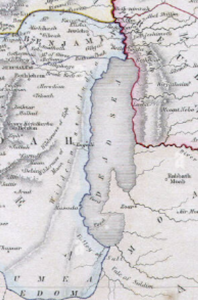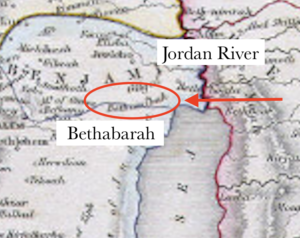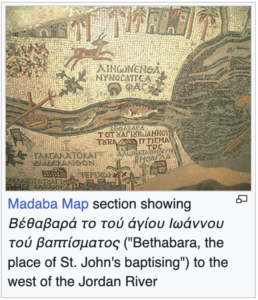In 1946 caves were discovered in the Middle East at Qumran in the Palestinian Territory of the West Bank that contained clay jars containing ancient scrolls and parchments.
Almost 15,000 scrolls and fragments were found. The contents of the scrolls were not made public nor even available to most scholars and researchers until the 1990s.
The location of the caves is modern-day Qumran which was called Bethabarah (also: Betharabah, Bethany) in the Bilbe. It is more on the Jordan River than on the Dead Sea, being a fresh water location for baptizing. The large map on the left shows the Dead Sea. The northern end where the Jordan River flows into it and the location of Bethabara are shown in the smaller inset map below.


A search for “Bethabara” in Wikipedia brings up information about an archeological site called “Al-Maghtas” which means “baptism”. It has been determined to be the location where John, the Baptist, baptized and ran his ministry. It is also called Bethany.
John 1:28 These things took place in Bethany beyond the Jordan, where John was baptizing.
John 10:40 He went away again across the Jordan to the place where John had been baptizing at first, and there he remained.
The next map below shows that the location is west of the Jordan River. Notice that East is at the top. This is a picture of part of a mosaic tile floor from the 6th century.

Conclusion: The community in Qumran, or Bethabara, or Bethany was the home and headquarters of John, the Baptist, and his relatives and disciples.
Exiled Temple Priests or Essenes?
It is a commonly held view that the Essenes, a Christian sect, lived there and were the ones who wrote, copied, and stored the scrolls and documents. However, Pliny, the Elder, placed the home of the Essenes in Engedi, which is 25 miles further south on the west coast of the Dead Sea. Also there are no mentions of the Essenes in the Dead Sea Scrolls nor in the scriptures even. However in the Dead Sea Scrolls, the terms “Sons of Zadok, Sons of Aaron, Sons of Levi, and Levites” are found 112 times.
The Damascus Document says that “the sons of Zadok are the elect of Israel, the men called by name who shall stand at the end of days.” p. 132
Scripture was found there and was no longer in Jerusalem so it is logical that the exiled Temple Priests who were the Sons of Zadok and who were in charge of keeping and copying scripture brought it with them when they left the temple.
This exile took place in 165 B.C. when the Hasmoneans took control of the temple worship. The high priests were not from the line of Aaron and were unqualified to act as priests.They instituted worship in the Temple and exiled the true priests, Sons of Zadok (who were from the line of Aaron). These true priests took the scriptures with them to Bethabara, completing the “chain of custody” of the scriptures in the hands of God’s anointed priests.
The true residents of Qumran and the keepers of the scrolls were the Temple Priests who were exiled from Jerusalem in 165 BC when the Maccabees and the Hasmoneans moved from Samaria into Judah and took control of the temple worship.
Scrolls that pass the test of Scripture (inspired Word of God)
